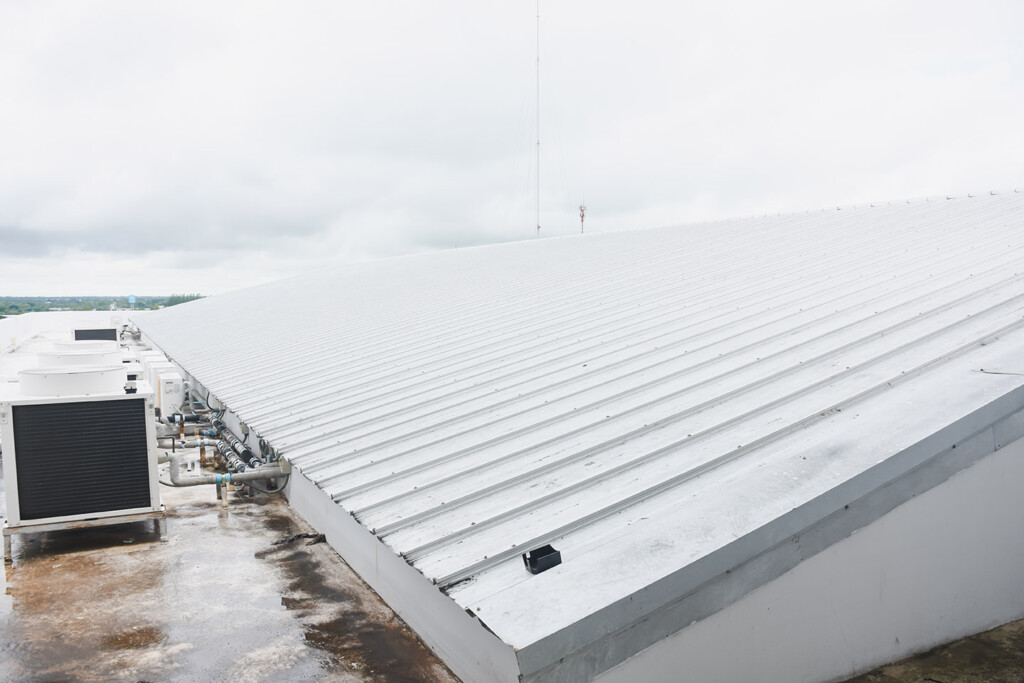Winterizing Tips for Your Commercial Roof
Although facility managers may be familiar with how heat can affect a commercial roof, they may not think about the negative effects winter weather can have on their commercial building roof type. More specifically, how snow, ice, sleet, and extremely cold temperatures can impact it. This blog will address winter elements, how they affect a commercial roofing system, and what you can do to winterize your roof.

Winter Elements
Commercial roofs are exposed to several harsh elements during the winter months that can impact their integrity and performance. The first issue facing a commercial roof during the winter months is snow accumulation. If a large storm moves in and dumps a lot of snow it can put a tremendous amount of weight on a roof, especially if it’s flat. If the weight of the snow exceeds the roof’s load-bearing capacity, it can lead to structural damage or even roof collapse.
The second element that comes into play during the winter is the snow ‘freeze-thaw’ cycle. Repeated freezing and thawing of moisture trapped in roofing materials or small cracks can cause building materials to expand and contract. This can worsen existing cracks in a roof, creating leaks and weakening the roof membrane. The freeze-thaw cycle can also lead to the deterioration and splitting of roofing components, such as shingles, flashing, and membranes.
A third element, which can occur due to the freeze-thaw cycle, is the formation of ice dams. When the snow on top of a roof melts due to heat escaping from the building, the water can refreeze, leading to the formation of ice dams. As the melted snow flows to the cooler edges of the roof, it refreezes and forms a dam that can block water from draining properly. If the dam is not eliminated, water can leak inside your facility through the roofing material and cause water damage and mold growth.
Once temperatures start to warm above freezing, a fourth winter element having a negative impact on your commercial roof is ponding water. In addition, if the drainage systems are blocked or inadequate on a flat or low-slope commercial roof, snowmelt may accumulate and form puddles. This standing water can also refreeze, adding extra weight and stress to the roof.
And because the U.S. continues to experience more extreme weather due to climate change, thermal shock can be an issue as it occurs when there is a sudden temperature fluctuation. A rapid temperature change between the day, when the sun comes out and warms things up, and the night, when temperatures dip below freezing, results in roofing materials expanding and contracting too quickly. This phenomenon can also cause roofing materials to crack and degrade over time. Learn more about roof expansion and contraction.
Steps to Ensure Your Roof is Winter-Ready
How can a facility manager ensure their commercial roof can withstand heavy amounts of snow, the freeze-thaw cycle, ice dams, ponding, and thermal shock? Here’s a guide to help ensure your roof is winter-ready.
The most important thing you can do to prepare your roof for winter is to have a commercial roof assessment performed during the Fall. If you don’t have someone on staff to do this, hire a roofing specialist like Capital Roof Care (CRC) who can create a commercial roof maintenance plan for your facility. A CRC roofing expert will walk the roof and identify:
- Cracks, tears, or holes in the membrane
- Worn or missing shingles
- Distress to the flashing to ensure the metal flashing around chimneys, vents, and other projections are intact and properly sealed
- Cracked or loose seams where sections of the roof meet; if this area is neglected, water can penetrate
- Ponding water
CRC can also schedule mid-winter inspections to check for issues like ice dams, ponding water, or clogged drains. If any damage is detected, CRC will make any necessary repairs before small problems become a roofing emergency.
You can also prepare your roof for winter by clearing debris. This includes removing leaves, branches, and dirt from the roof’s surface to prevent blockages in the drainage system. It’s also a good idea to trim any trees that are near or touching the roof. A fallen tree or debris as the result of a winter storm can result in an unwanted emergency roof repair cost.
You should also address any structural issues that could present challenges. Reinforce areas prone to heavy snow accumulation or ice formation, such as valleys and overhangs, by adding snow guards or installing an ice and water shield. You may also consider applying a weatherproof roof coating or sealant to the roof membrane to extend the life of your roof and prevent moisture penetration during winter months.
The final step to take before winter is to develop a snow removal plan. Create a strategy to safely remove snow without damaging the roof membrane, which is especially important if you have a flat roof. In addition, before the start of winter, hire a professional snow removal service to be “on call” to clear heavy accumulations. This will ease your stress knowing the snow and ice loads on your roofing system will be safely cleared.
By being aware of the winter elements that can have a negative impact on your commercial roof and taking the necessary steps to ensure your roof is winter-ready, you can prevent costly repairs and ensure your roof lasts longer despite harsh weather conditions.